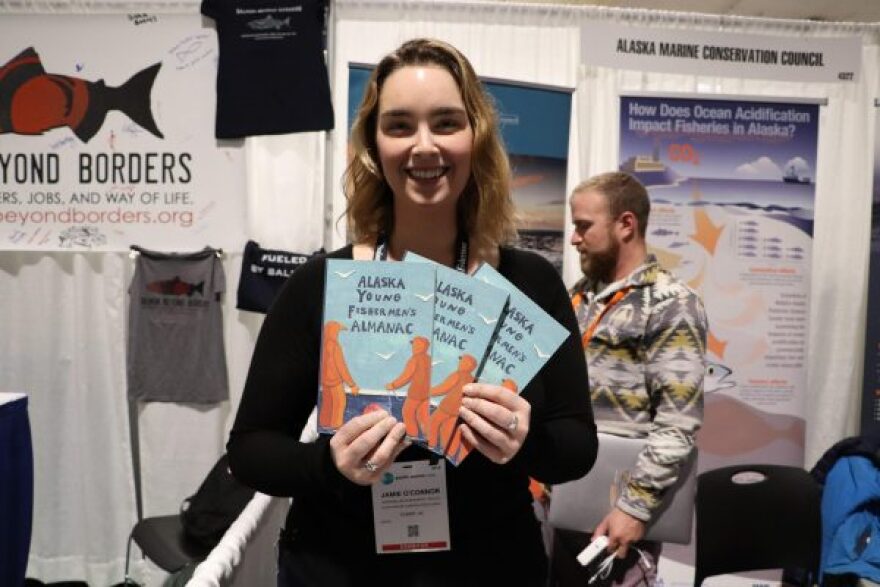Over 500 vendors exhibited at the 2019 Pacific Marine Expo in Seattle in late November. For commercial fishermen, processors and small businesses, it’s the place to be.
The expo was winding down on Saturday morning. But Naknek fisherman Reba Temple was causing a stir with her unusual get-up, made of the mesh netting that salmon tenders use to collect a catch.
“It’s made out of scraps of brailer material. So there’s grommets and mesh brailer material and black straps, and it’s a ballgown,” she said.
Temple said the expo is a great place to catch up with the people and the products in the industry.
“Everyone’s here, you can talk to your processors, you can talk to your friends, see hydraulic pumps cut open so you actually know how they work,” she said.
Stickers and signs saying NO PEBBLE MINE adorned booths, as they have for the past decade. The mine would tap large copper and gold deposits near the headwaters of two major river systems in Bristol Bay. And as the Trump administration breathes new life into the project, many people here are worried.
“Nothing in the world has zero risk — especially when you have a mine of this size with the existing data that show very definitively that there will be impacts,” said Daniel Schindler, director of the University of Washington’s Alaska Salmon Program.
Schindler is based in Seattle but spends summers in Bristol Bay. He kicked off the expo’s keynote panel — an update on how the Pebble proposal is winding through the federal permitting process. The U.S. Army Corps of Engineers released its draft environmental review in February. A final draft is expected in a few months. The Environmental Protection Agency’s regional office has weighed in with some concerns. And Schindler is worried, too.
“The waste that they produce will have to be stored on site. And people talk about ‘in perpetuity,’ and that sounds like a biblical term. But it’s a reality. This material that will be left behind will be there until the next ice age,” he said.
National Fisherman magazine’s Editor-in-Chief Jessica Hathaway moderated the discussion, which examined concerns about the project. The Bristol Bay Regional Seafood Development Association and the Bristol Bay Native Corporation were also represented on the panel.
Pebble spokesperson Mike Heatwole said the partnership would have liked to participate in the panel, but was not invited.
"The public comment period generated constructive input from the public and regulatory agencies," he said in an email. "All comments must be addressed in a final EIS for the project. We have been working on responding to a series of requests for information from the USACE about issues raised through that process."
But it’s not all resource politics here. Jamie O’Connor is a program manager for the Alaska Marine Conservation Council, which recently published a collection of poems, stories, art and recipes from 50 young fishermen. She herself works a set net site in Bristol Bay, in Ekuk. It’s the second volume of the Alaska Young Fisherman's Almanac.
“I’ve heard from folks who fish who told me that they turn to it when they’re feeling kind of lonely for some of that fish magic," she said. "And then people outside of the industry can get a really good look at what it’s like to do what we do, and why it’s important and why it should be preserved.”
More than 50 entries from young fishermen and mentors make up volume two, which was printed with the proceeds from volume one. The almanac is created and produced entirely in Alaska. Homer artist Oceana Wills did the cover art, and the almanac was designed by Caroline Ernst, from Sterling.
The economic outlook for Bristol Bay, meanwhile, is mixed. The preliminary exvessel value — the total amount paid to fishermen in 2019 — broke all previous records this year. But the news wasn’t all stellar. A regional fisheries marketing group, the Bristol Bay Regional Seafood Development Association, says wholesale prices for fillets, headed and gutted fish, and farmed salmon were all lower, and so was sales volume.
Michael Jackson is a director of the association. He said Bristol Bay’s success is tied to its ability to deliver high grade, bruise-free fish.
“We heard some concerns and we’re trying to address them," he said. "We’re always concerned about quality. So we’ve got an ice infrastructure program that we’re trying to broaden and make it more robust. So we’re trying to make that available in all districts, in all places.”
Not all of the businesses were Pacific Northwest giants headquartered around Seattle. By all accounts, the Naknek-based Bristol Bay Brailer Company had a whirlwind three days selling brailers. Company manager Diane Hill says they’re going into their fifth season and it’s looking busy.
“There’s a lot of new boats being built, and they’re interested in our brailers," Hill said. "I think our biggest challenge is our population’s so small, is finding full-time workers, so we are hesitant to introduce new products till we have a really good, solid staff year-round. So we’ll just stick with our basics and see what happens from there.”
The three-day event wrapped up Saturday. But many of these people will be seeing each other again in the not-too-distant future. There’ll be a reunion of sorts this summer in Bristol Bay when the fishing begins in earnest.
Contact the author at isabelle@kdlg.org or 907-842-2200



